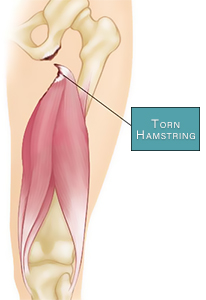
When someone refers to a hamstring injury, it is when you pull or strain a hamstring muscle. These muscles run along the back of your thigh. Hamstring injuries are more likely to occur if you play certain sports, such as soccer, basketball, football, and tennis. These sports involve sudden stops and starts. In addition, dancers and runners also commonly injure their hamstrings.
There are many self-care measures, such as ice, rest, and pain relievers. Most of the time, these are the only treatment method that is necessary. Surgery is not common for this injury, however, it is possible surgical intervention may be needed to repair a hamstring tendon or muscle.
Symptoms of a Hamstring Injury
When an injury to the hamstring occurs, it’s common for a sudden sharp pain to happen in the back of your thigh. Sometimes, a popping may occur or a tearing sensation. Additionally, some people also experience:
- Bruising
- Discoloration on back of the leg
- Muscle Weakness
- Non-weight bearing
Causes of the Injury
When you extend your leg beyond its capability during physical activity, a hamstring injury can occur.
Risk Factors of the Injury, such as:
- Sports Players. Sports that require sprinting or running, or other activities such as dancing that might require extreme stretching, make a hamstring injury more likely.
- Poor flexibility. If you have poor flexibility, your muscles may not be able to bear the full force of the action required during certain activities.
- Previous hamstring injury. After you’ve had one hamstring injury, you’re more likely to have another one, especially if you try to resume all your activities at pre-injury levels of intensity before your muscles have time to heal and rebuild strength.
- Muscle imbalance. Although not all experts agree, some suggest that a muscle imbalance may lead to a hamstring injury. When the muscles along the front of your thigh — the quadriceps — become stronger and more developed than your hamstring muscles, you may be more likely to injure your hamstring muscles.
Treatment for Hamstring Injuries
When treatment first begins, the goal should be to reduce pain and swelling. To accomplish this the most common recommendations are as follows:
- Apply ice to the injured area to reduce pain and inflammation
- Take time out of strenuous activities for your hamstring to heal
- Utilize a cane or crutches to avoid bearing weight
- Wrap area with a bandage to reduce swelling
- Rest and elevate your leg to minimize swelling and reduce drainage
- Over the counter pain relievers to reduce pain and inflammation
Physical Therapy:
This is always a good option after an injury. A physical therapist can help you get back on your feet. They will teach you exercises that are geared toward your specific injury.
Surgical Options
Although surgery is not typical for this injury if the muscle has pulled free from where it’s connected, a surgeon must reattach it. Severe muscle tears can also be repaired through surgical intervention.
If you have torn a muscle and are not experiencing relief, call us today at 888-409-8006. A top specialist will be glad to help! Offices conveniently located in Boca Raton, Deerfield Beach, Coral Springs & Plantation.
